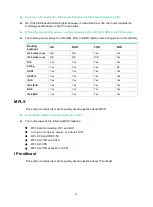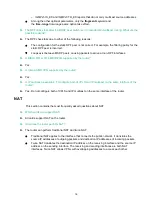
13
Q.
Does the router support cross-card link aggregation?
A.
Yes. You can use interfaces on any cards for cross-card link aggregation except an FIP-600 or
SAP-4EXP card.
IP routing
This section contains the most frequently asked questions about IP routing.
Q.
Does the router support configuring blackhole routes?
A.
Yes. A blackhole route is a static route whose output interface is Null 0. The router discards the
matching packets without sending ICMP messages to notify the source host. To prevent IP attacks,
you can configure blackhole routes to discard packets destined for specific destinations. The
following example shows how to configure a blackhole route:
<Sysname>system-view
[Sysname]ip route-static 1.1.1.1 32 null 0 preference 1
Q.
Is the OSPF cost of a Layer 3 Ethernet interface on the router relevant to the interface rate?
A.
Yes. By default, a Layer 3 Ethernet interface automatically computes its OSPF cost according to the
interface rate with the following formula: Interface OSPF cost = Bandwidth reference value (100
Mbps) / Interface rate (Mbps).
If the calculated cost is greater than 65535, the value of 65535 is used. If the calculated cost is
smaller than 1, the value of 1 is used.
Q.
What are the preferences of different routing protocols?
A.
Routing protocols, including static routing, each have a preference by default. If they find multiple
routes to the same destination, the router selects the route with the highest preference as the
optimal route. The preference of a direct route is always 0 and cannot be changed. You can
configure a preference for each static route and each dynamic routing protocol.
route types and default preferences. The smaller the value, the higher the preference.
Table 3 Route types and default route preferences
Route type
Preference
Direct route
0
OSPF
10
IS-IS
15
Static route
60
RIP
100
OSPF ASE
150
OSPF NSSA
150
IBGP
255
EBGP
255
Unknown (route from an untrusted source) 256




















